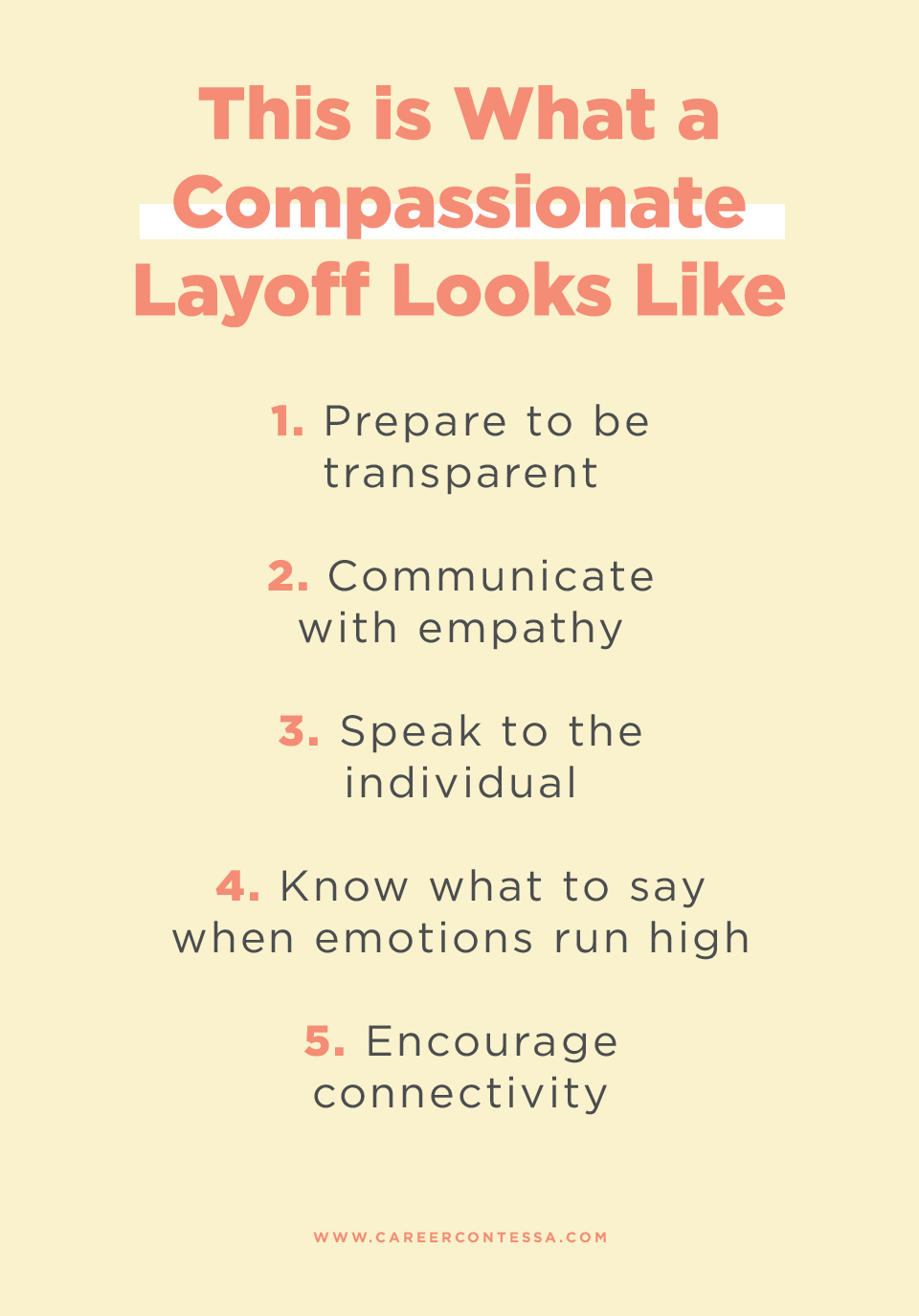This article by Lydia Dishman was originally published by Fast Company and is reprinted with permission
Twenty million.
That staggering figure is the number of jobs lost in April alone, according to the Bureau of Labor Statistics. Economists are calling it the worst unemployment rate since the Great Depression.
And behind every job lost is a CEO, manager, or business owner who has to tell that person that they are no longer employed. This is never easy, but during a pandemic with most people working remotely, getting the news via email, chat, or a video call can complicate an already challenging communication.
Unsurprisingly, the COVID-19 crisis has illuminated some who have handled layoffs with respect, and plenty of others who have dropped the hammer with little regard for the person behind the pink slip.
Airbnb’s chief, Brian Chesky, sent a heartfelt email, explaining the decision to cut 1,900 of its 7,500 employees. It has been lauded as an example of how such a difficult thing should be handled. The company also promised laid-off staffers 12 months of health insurance coverage and 14 weeks of severance (with additional weeks based on individual tenure).
In contrast, 30% of the workforce at the electric scooter company Bird were told they’d been cut in a two-minute Zoom call. According to a report in Business Insider, CEO Travis Vanderzanden told those gathered with his video turned off (which he later explained in a tweet that was to serve as a “more humane” way to handle delivering the news). The company’s managers were told to contact individuals directly after the call.
Unfortunately, months into the crisis, companies are still furloughing and laying off workers as the economy reels. Is there a more compassionate way to handle these difficult conversations? We polled a few experts to discover best practices that start well before the employee gets laid off, and extends through the talk and the aftermath.
Prepare to be Transparent
“Even before announcing layoffs, organizations should work with their HR team to develop key messages that will need to be delivered to employees,” says Randstad RiseSmart senior practice development manager Kimberly Schneiderman.
She believes company executives need to be as transparent and truthful as possible about the reasons for the layoffs, so those who are let go will be better able to process the news. And this can be achieved via a letter like Chesky’s, of Airbnb.
“The most successful letters have been transparent about the reasons for the layoffs, the steps the company took in determining impacted employee groups, what the company is doing moving forward, and what is being provided to the impacted employees—severance, paid medical insurance, outplacement, etc.,” Schneiderman says.
Cara Brennan Allamano, senior vice president of people, places, and learning at Udemy, says that planning to offer such provisions can go a long way to make people feel they are being treated with the same respect on their way out of the company as they did on their way in. “I really admire how a Udemy for Business customer decided to continue providing online learning resources to laid-off individuals,” Brennan Allamano says. “They found a tangible way to support people even when they could no longer be with the company.”
Taking the time to craft a sincere message around what the company will provide for its people comes with an added bonus, Schneiderman adds. “The letters also convey the compassion of the company in plain language,” she notes. “Transparency and heartfelt messaging have gone a long way in protecting the brand with consumers.”
Communicate With Empathy
Messaging doesn’t end with outward-facing communications. Amber Cabral, founder of the leadership consultancy Cabral Co., says that oftentimes leaders hide behind explanations, such as, “It is a business decision,” or other language that feels very formal and distant because it puts some emotional space between themselves and the discomfort of a layoff or furlough.
“While it might make it emotionally easier on leaders,” Cabral cautions, “it can isolate, create distrust, and even demean impacted employees.”
Although it may seem counterintuitive, Cabral urges managers to push past the discomfort. “Find the empathy to communicate how much employees are valued,” she advises, “and that the job impacts due to COVID-19 are not an indicator of their personal performance, but instead a sign of the times.” It’s an inclusive approach that ensures employees understand they’re respected members of the team—even during tough times.
Speak to the Individual
Respect can be shown through language, but also in actions. “While it may be more efficient to terminate a large group of employees all at once,” says Brennan Allamano, “try to find a way for managers to share the news directly with their reports.” She points out that losing a job is emotional enough. “Having to experience it with a large virtual group of coworkers only adds to the stress.”
Schneiderman also suggests acknowledging that the employee is likely not alone at home. “Managers should be aware that the recipient of the news may be in a room where children or other adults can overhear the message and should be sensitive to that. She advises telling the employee that the conversation is private and making sure they can get to a place where others can’t listen in. It may be revealing, she says, but necessary to respect the privacy of the individual receiving the information in the immediate moments after the news is delivered.
Additionally, Brennan Allamano says it shouldn’t be a one-sided conversation, for both the people who are being let go as well as those who stay. “Employees will have questions and want to feel heard,” she says. “For individuals that are laid off, determine the best forum to answer their questions and provide more than one channel for connection,” Brennan Allamano says. “For the rest of your workforce, be prepared for questions surrounding their own job uncertainty.”
Know What to Say When Emotions Run High
Uncertainty and stress can trigger conflicted behavior, even in the most collected individuals. Schneiderman says if an employee is angry, the manager should allow the employee to express their feelings without judgment. “It can help if the manager says, ‘I know this is difficult news to hear,’ in a lowered tone to help to de-escalate the situation,” she suggests.
The statement also sends the message that there is no changing the decision. Schneiderman cautions not to agree with the employee or apologize. “It can make them think they are a victim of wrongdoing, which opens the company up to litigation,” she says. “Don’t counsel the employee, tell them that this is a blessing, or they’ll be better off in the long run,” Schneiderman adds.
According to Schneiderman, it’s better to say things like:
- I know this is difficult news to hear.
- I hear your frustration.
- The decision is final.
- We need to review the next steps and the support you will be provided during this transition. Can I give you these details now?
Encourage Connectivity
Cabral says it’s important to recognize that layoffs can be an opportunity to exercise inclusion, too, and to consider ways to ensure those leaving the company don’t feel like they are alone. She says there are several ways to do this, including encouraging team members to connect on LinkedIn, starting a program to help furloughed employees prepare for their next opportunity, or pulling together a list of resources—from mental health services to résumé support.
“For many of us, our jobs make up a huge part of our identity and self-worth, so the loss can be psychologically damaging,” Cabral points out. “Ensuring employees have a way to stay connected and feel supported through the transition is key to helping people retain their sense of identity as they adapt to the changes to come.”
Further, Cabral says, as unpredictable as COVID-19 has been, it has followed some sadly familiar trends. “The soaring unemployment rate is impacting people of color the most,” she says. Cabral says that responsible employers will pay attention to demographics and if they do have to lay off employees from underrepresented groups, they need to be inclusive. “[That] means making sure to exercise awareness of the unique challenges that unemployment presents to underserved populations,” she says. “Employers can work to tailor packages that provide support that is meaningful for underserved communities,” says Cabral, such as extending health benefits for the rest of the year or partnering with a staffing firm to help displaced employees find their next opportunity.
Overall, says Brennan Allamano, it’s simple. “Knowing that care and consideration were taken with this tough choice reflects the respect affected employees deserve.”
More from Fast Company:











